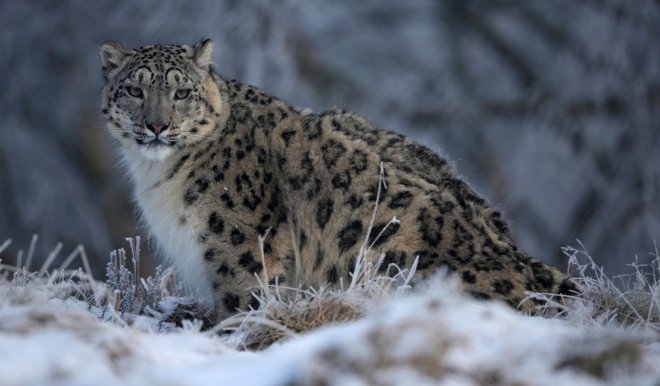
Here's a chunk of good news to the bewildering strain of snow leopards. The Red List classification from the International Union for Conservation of Nature – IUCN, promulgates the conservation status of this giant cat family from "Endangered" to "Vulnerable". Unfortunately, Asia's prominent insignia, dwelling in the great mountains still remains pregnable to numerous threats, furthermore making the existence of the species vulnerable to constant peril.
The IUCN Red List is a globally accepted, international standard for evaluating extinction risk, comprising of 5-10 year assessments, including the rudimentary data of 1972. The analytical data by the IUCN had previously proclaimed this mysterious cat family as "Endangered".
A 3-year assessment was processed by a group of 5 international experts, including scientists from academia, Panthera, Snow Leopard Conservancy and Wildlife Conservation Society. The data was then evaluated and scrutinized and later approved by 8 international felid and Red List assessment experts, the IUCN global assessment team and the central red list unit.
As per an analysis by Tom McCarthy, the Executive Director of Snow Leopard program told Panthera that in order to classify a particular species as "Endangered", it requires a global population of lesser than 2500 mature adults with a 20% declination over a period of 16 years. The snow leopard family did not meet this specific criterion.
McCarthy further stated that being "Vulnerable" is a better status than being "Endangered" but it does not confirm the safety of the species. They are still prone to "high risk of extinction in the wild" according to the IUCN. The snow leopards are still declining although the rate is low. "To be considered 'Endangered,' there must be less than 2,500 mature snow leopards and they must be experiencing a high rate of decline. Both are now considered extremely unlikely, which is the good news, but it does not mean that snow leopards are 'safe' or that now is a time to celebrate. The species still faces 'a high risk of extinction in the wild' and is likely still declining – just not at the rate previously thought" McCarthy stated.
Loss of habitat, increased rate of poaching, human-snow leopard tussle are the causes behind the gradual down drift of this amazing species.
The assessment shows that a number of studies on the same that used more vigorous methods reveal an increase in the number of snow leopards as opposed to the past calculations.
"Even with such positive supportive information, the assessment team took a conservative approach, including using the lowest estimated global population size of 4,000 when determining if the Endangered threshold could be met" said Rodney Jackson, Founder and Director of the Snow Leopard Conservancy (SLC) and a member of the assessment team.
Improved conservation efforts have greatly developed the status of the snow leopards.
David Mallon, snow leopard expert and another member of the assessment team, indicated that a generous growth in the number of protected areas within the snow leopard range has been noticed, primarily in the last few decades.
The species covers a vast, 1.8 million square kilometers of mountain habitat in 12 countries across Asia.
World's greatest predators are found primarily in the extensive mountain chains, such as the Himalaya, Karakoram, Hindu Kush, Tien Shan, Altai and other mountainous regions of Asia. These areas are beyond the reach of the civilized world. Despite such an impossibility, the snow leopards face numerous threats.
"Continuing threats include poaching for its thick fur and overhunting of its wild prey," said Peter Zahler, Coordinator of the WCS Snow Leopard Program and also on the assessment team. "There is also an increasing number of domestic livestock raised by local people in these high mountains that degrades the delicate grasslands, disturbs wild sheep and goats and drives them into less productive habitats."
Transmission of novel pathogens and other such bacteria and viruses from the carcasses of the wildlings might spread to the rest of the wild cattle or domestic livestock being raised by the local people. Being inattentive to these details might prove fatal to the denizens of the grasslands, leading to the outbreak of diseases.
"It is important that a change in status is not misinterpreted – this change does not mean that the snow leopard has been 'saved' and efforts on its behalf can stop. The IUCN's Vulnerable status means a species is still vulnerable to extinction, and the snow leopard population is still believed to be in decline and facing a high risk of extinction. Threats – poaching, habitat destruction, loss of prey species – still exist and new threats such as roads, border fences, and climate change, are increasing. So conservation actions must continue and be increased to conserve the species" Zahler further added.
Cats are important!
In order to maintain a healthy and a well-balanced bio-diversity and ecological balance, each stratum of nature's pyramid needs to be equitable. Unfortunately, an increase in the rate of deforestation which immediately resulted in global warming and higher levels of toxic elements in the air, have nearly washed out significant species from the plant and animal kingdom alike and stretches of grasslands from the face of the earth. Cheetahs, jaguars, leopards, lions, pumas, snow leopards, and tigers; the giant cat family are facing constant threat due to poaching and other environmental hazards. Cats are important to help sustain the vast landscapes and greenery, the flora and the fauna across the whole world.
An improvement in the status of the once-endangered wildlings is a huge step in making the world a better place. It is time to make mother nature feel at home again.









